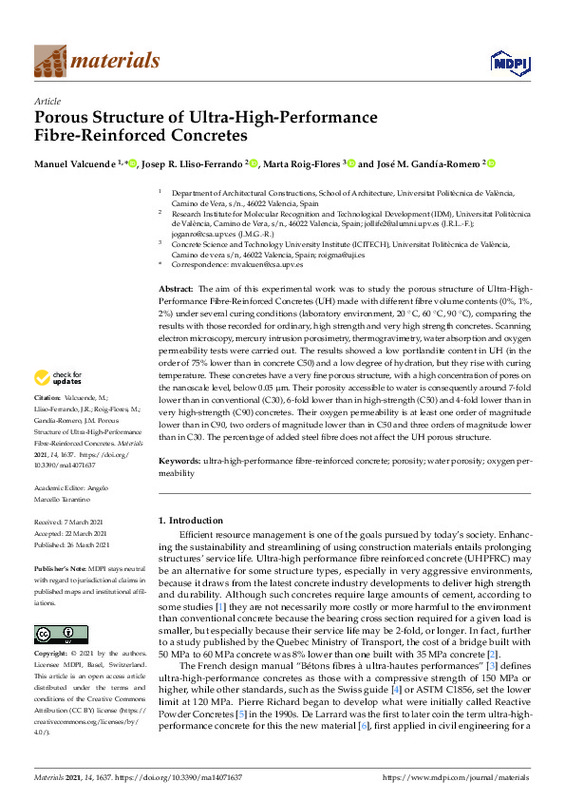JavaScript is disabled for your browser. Some features of this site may not work without it.
Buscar en RiuNet
Listar
Mi cuenta
Estadísticas
Ayuda RiuNet
Admin. UPV
Porous Structure of Ultra-High-Performance Fibre-Reinforced Concretes
Mostrar el registro sencillo del ítem
Ficheros en el ítem
| dc.contributor.author | Valcuende Payá, Manuel Octavio
|
es_ES |
| dc.contributor.author | Lliso-Ferrando, Josep Ramon
|
es_ES |
| dc.contributor.author | Roig-Flores, Marta
|
es_ES |
| dc.contributor.author | Gandía-Romero, Jose M.
|
es_ES |
| dc.date.accessioned | 2022-01-20T19:30:39Z | |
| dc.date.available | 2022-01-20T19:30:39Z | |
| dc.date.issued | 2021-04 | es_ES |
| dc.identifier.uri | http://hdl.handle.net/10251/180038 | |
| dc.description.abstract | [EN] The aim of this experimental work was to study the porous structure of Ultra-High-Performance Fibre-Reinforced Concretes (UH) made with different fibre volume contents (0%, 1%, 2%) under several curing conditions (laboratory environment, 20 degrees C, 60 degrees C, 90 degrees C), comparing the results with those recorded for ordinary, high strength and very high strength concretes. Scanning electron microscopy, mercury intrusion porosimetry, thermogravimetry, water absorption and oxygen permeability tests were carried out. The results showed a low portlandite content in UH (in the order of 75% lower than in concrete C50) and a low degree of hydration, but they rise with curing temperature. These concretes have a very fine porous structure, with a high concentration of pores on the nanoscale level, below 0.05 mu m. Their porosity accessible to water is consequently around 7-fold lower than in conventional (C30), 6-fold lower than in high-strength (C50) and 4-fold lower than in very high-strength (C90) concretes. Their oxygen permeability is at least one order of magnitude lower than in C90, two orders of magnitude lower than in C50 and three orders of magnitude lower than in C30. The percentage of added steel fibre does not affect the UH porous structure | es_ES |
| dc.description.sponsorship | This research was funded by Ministerio de Economia Y Competitividad (Agencia Estatal de Investigacion) of the Spanish Government, Grant number BIA2016-78460-C3-3-R | es_ES |
| dc.language | Inglés | es_ES |
| dc.publisher | MDPI AG | es_ES |
| dc.relation.ispartof | Materials | es_ES |
| dc.rights | Reconocimiento (by) | es_ES |
| dc.subject | Ultra-high-performance fibre-reinforced concrete | es_ES |
| dc.subject | Porosity | es_ES |
| dc.subject | Water porosity | es_ES |
| dc.subject | Oxygen permeability | es_ES |
| dc.subject.classification | CONSTRUCCIONES ARQUITECTONICAS | es_ES |
| dc.title | Porous Structure of Ultra-High-Performance Fibre-Reinforced Concretes | es_ES |
| dc.type | Artículo | es_ES |
| dc.identifier.doi | 10.3390/ma14071637 | es_ES |
| dc.relation.projectID | info:eu-repo/grantAgreement/AEI//BIA2016-78460-C3-3-R//DURABILIDAD Y VIDA UTIL DEL HORMIGON DE MUY ALTO RENDIMIENTO/ | es_ES |
| dc.rights.accessRights | Abierto | es_ES |
| dc.contributor.affiliation | Universitat Politècnica de València. Departamento de Construcciones Arquitectónicas - Departament de Construccions Arquitectòniques | es_ES |
| dc.contributor.affiliation | Universitat Politècnica de València. Instituto de Ciencia y Tecnología del Hormigón - Institut de Ciència i Tecnologia del Formigó | es_ES |
| dc.description.bibliographicCitation | Valcuende Payá, MO.; Lliso-Ferrando, JR.; Roig-Flores, M.; Gandía-Romero, JM. (2021). Porous Structure of Ultra-High-Performance Fibre-Reinforced Concretes. Materials. 14(7):1-18. https://doi.org/10.3390/ma14071637 | es_ES |
| dc.description.accrualMethod | S | es_ES |
| dc.relation.publisherversion | https://doi.org/10.3390/ma14071637 | es_ES |
| dc.description.upvformatpinicio | 1 | es_ES |
| dc.description.upvformatpfin | 18 | es_ES |
| dc.type.version | info:eu-repo/semantics/publishedVersion | es_ES |
| dc.description.volume | 14 | es_ES |
| dc.description.issue | 7 | es_ES |
| dc.identifier.eissn | 1996-1944 | es_ES |
| dc.identifier.pmid | 33810603 | es_ES |
| dc.identifier.pmcid | PMC8036622 | es_ES |
| dc.relation.pasarela | S\433852 | es_ES |
| dc.contributor.funder | AGENCIA ESTATAL DE INVESTIGACION | es_ES |
| upv.costeAPC | 1975 | es_ES |








